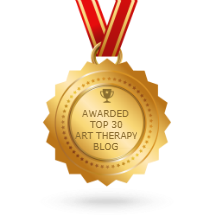
It is on the longish side today and a bit psychological.
I started to draw when I had a very strong pain. I held on to the act of drawing as to something that saved me from sinking in a bog of pain. I did not want to loose my humanity. I also held on to drawing because I wanted to have some sort of a backbone, when everything else was breaking apart to meaningless good-for-nothing, directionless pieces.
The top left part, where I started the lines, is a possible visual interpretation of pain, sharply spreading, attacking everything in all directions.
Then I left the stage, so to speak. The first spontaneous burst of drawing calmed me down a little, and my by-now-natural-tendency to go deeper into myself, to allow for a deeper view to emerge took over.
This created, still in the ’lines’ department, a pen-like thing, thin and clumsy, self-guarding like a soldier in uniform, standing straight and holding with one hand this grand explosion, almost as if it is a flower. I did not think this thought when I drew. I just drew what came to me, basically not knowing what I was doing. Or you can say, I was trusting my inner guidance.
This soldier is supported by a complicated and inefficient scaffolding, in yellows and browns. The yellow color does not give a sense of strength to the scaffolding.
This scaffolding has another shape, in green, connected to it on one side. In that shape, there are teeth that are pointing inward, like an aggression that is directed inward.
I can almost say that it feels as if the scaffolding is trying to push this green part away, but can’t get rid of it. (The colors don’t feel good together.)
The color areas create two layers. To say it in a short way, the blue is behind everything else.
The layer of the pink, browns, yellows and reds is like an emotional echo of what the lines do. In the middle there is the aggression in all directions (in pink), and the rest are all the broken parts, including the spectacularly dramatic yellow in the upper left corner. There is drama there, no doubt.
In blue there are bridges above and under each other in what can go on forever without giving a sense of meaning, since it does not seem to matter if you go up or down. This adds to the meaninglessness.
So what did the diving-in bring up?
A big confusion, happening without any clear purpose, destructing something emotional while holding on as much as possible to the figure of the soldier, as the protagonist, who is being propped up somehow by a needlessly complicated scaffolding and showing off its anger as a flower.
Wow.
Or maybe I should say woe.
Isn’t the soldier like the ego? So fearful, so lost and confused, but pretending to be strong, accompanied by self-hatred, and displaying some dramatic fireworks while feeling so limited.
So what good is that for? What did I gain from drawing?
Seeing that this pain event creates such a sorry state requires two participants.
One is the event itself with all that happens. The second is the seer, the one who witnesses. And you have to admit that the seeing is pretty comprehensive, psychologically speaking. The pain has become a richer event, with self-hatred, with the inflexibility and fear of the ego, with all that is constructed to keep the ego in place, with the complexity of what holds the ego in place, and with displaying the drama almost as a way to decorate the ego.
First came the initial scream. The viewer at that point was the ego himself. Then, with calming down, it became possible to choose a different perspective to look from, by using a different style of consciousness. Instead of the narrow style, of one thought after another, of cause and effect along the same path, the attention started to be given to everything at once, to all the participating shapes and the way they relate to each other.
When there is a strong emotional response, one thing becomes the most important one, while everything else disappears from view. But from the wider view, the relative importance of the pain diminishes, and all the parts and their relationships can be seen at once. So you see the whole structure of the event. It does not have a purpose and it does not have a hero.
How does consciousness change?
Just by making art, in which composition is of the most importance. If you want to make something that has beauty for you, you must pay attention to the composition. When you do that, the diving into a wider (and deeper) state happens on its own. I am talking here about why art is so powerful as the initiator of wellbeing.
With this deeper view and with the associations that arise, you start to know the complete situation, or you see in a more complete way than before.
Being in this relatively deeper state is pleasant. It gives a sense of control, of knowing, of peace and of being strong and unaffected by the suffering. It surely is a better state than the one it depicts.When I came to this stage, I did not feel the pain any more.
Before, when the pain was the most important thing, getting rid of it seemed to be the prerequisite for feeling better.
Now you become interested in changing the situation, not because you do not want to feel the pain but because you want to be in a different state, the state of the viewer. It is a totally different ballgame. You don’t need to have no pain in order to be happy. Happiness is yours by changing your perspective. It is insight. It is wisdom.
It is a big and meaningful change that is right under our noses.
If you do this many times, it becomes a habit. Suffering then leads you deeper and you feel better. You teach yourself to be free.



Dear intuitiveflow-er,
Your post beautifully illustrates a wonderful phrase from a favorite book, Man’s Search for Meaning:
Life holds a potential meaning under any condition, even the most miserable ones…in some ways, suffering ceases to be suffering at the moment it finds meaning. What man needs is not the discharge of tension at any cost, but the call of a potential meaning waiting to be fulfilled by him.” ~ Viktor Frankl
I am glad the pain-event subsided, and am heartened to know that because this works for one, it may work for others… thx for a helping of hope for all.
Hi Joni,
Thank you. Yes, it works. I have been doing things like this for a very long time and they always work. I helped others do it too. In one of my sessions I helped a client stop a terrible migraine. The thing to know is that you have to do it many times, when you want to resolve something that is chronic. A chronic ailment is the expression of a long held belief that has been repeated many times and gained a lot of momentum. So you have to stop supporting that belief, so it won’t collect more energy, and let the energy spill out freely. The energy spills when it is not being replenished by resistance to it. It may take a long time, as it has taken me. I can stop the pain many times. Not always. And you don’t see results for quite a long time, so it is easy to feel disappointment and leave the practice. The more time passes, I have more to say about it. I’m sure I’ll be writing about this more.